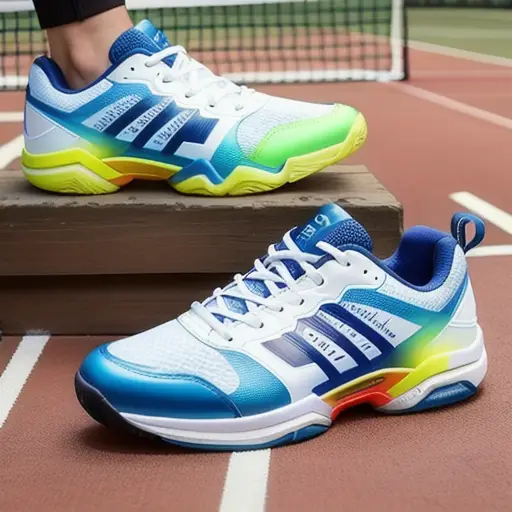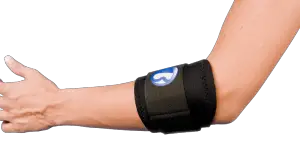Badminton shoes are designed for quick movement and lateral support, while tennis shoes are designed for forward and backward movement. Badminton shoes are not recommended for use in tennis due to the different playing surfaces and the different movements required for the two sports.
Yes, You can use badminton shoes for tennis, but it is not recommended. Badminton shoes are designed to provide grip and traction on a badminton court, which is made of soft, dry grass. Tennis courts, on the other hand, are typically made of hard surfaces like concrete or asphalt, which can be slippery. Wearing badminton shoes on a tennis court can increase your risk of slipping and falling. Instead, it is better to wear tennis shoes that are specifically designed for playing on hard courts.
The Differences between Badminton and Tennis
The key differences between badminton and tennis lie not only in the gameplay, but also in the footwear requirements for each sport. One primary distinction is the size of the court; tennis courts are approximately 3.5 times larger than badminton courts, necessitating more running and consequently increasing the impact on the player’s ankles and knees. As a result, tennis shoes tend to have more cushioning in the heel area to provide adequate support during vigorous lateral movements. Badminton shoes, on the other hand, prioritize grip for quicker reflexes and sudden changes in direction. The grip patterns on badminton shoes are usually radial, while tennis shoes have various grip patterns depending on the court surface. Additionally, badminton shoes are typically lighter than tennis shoes to allow quick and effortless movement during agile gameplay.
Court Surface Comparison: Badminton and Tennis
When it comes to court surfaces, badminton and tennis have their differences, which directly affect shoe selection for each sport. Badminton courts are typically constructed with synthetic polyurethane (PU) surfaces, which provide a good grip and cushioning for players. These courts are used in official world-class badminton competitions, and badminton shoes are specifically designed to cater to the needs of players on these surfaces.
Tennis courts, on the other hand, come in three types for competition play – grass, clay, and hard courts. Grass courts are fast yet slippery, requiring tennis shoes that provide adequate traction to avoid slipping. Clay courts have a slower pace due to higher ball bounce, and tennis shoes designed for clay courts have a zig-zag herringbone pattern on the outsoles to prevent clay from getting stuck. Lastly, hard courts, made from synthetic PU, are common in tennis and require durable and stable shoes for long-lasting support.
Therefore, due to the differences in court surfaces and the specific shoe requirements for each sport, it is not advisable to use badminton shoes for tennis or vice versa.
Shoe Design for Badminton and Tennis
The design of shoes for badminton and tennis is significantly different due to the distinct movements and court surfaces involved in each sport. Badminton shoes are typically lightweight with thin insoles to facilitate quick, multidirectional movements, while tennis shoes are designed to provide lateral support and cushioning for the frequent side-to-side and forward motions on larger courts. Moreover, badminton shoes are primarily made for synthetic PU courts, offering excellent grip and cushioning for falls. Tennis shoes, on the other hand, are specifically designed for grass, clay, or hard courts, each requiring a different type of sole pattern to ensure maximum traction and minimize the risk of injury. Hence, it’s crucial to invest in the appropriate footwear for each sport to ensure optimal performance and reduce the likelihood of injuries.
Movement Requirements for Badminton and Tennis
When considering the movement requirements in badminton and tennis, it is essential to understand the differences between the two sports. Badminton involves quick, agile movements and requires players to change direction frequently. The footwork in badminton is often compared to dancing, with players needing to move in all sorts of directions swiftly. This is due to the smaller court size and the fast-paced nature of the game. On the other hand, tennis is characterized by more forward and backward movement, with occasional lateral and diagonal movements. Tennis players mostly run side-to-side on the baseline and occasionally dash forward for drop shots. The larger court in tennis necessitates longer sprints and more extensive lateral movements, hence the need for shoes that provide adequate lateral support and grip. Overall, the distinct movement requirements in badminton and tennis call for sport-specific footwear to ensure optimal performance and minimize the risk of injury.
Similar Footwork in Badminton and Tennis
Although badminton and tennis have noticeable differences in terms of court size, pacing, and overall gameplay, the footwork involved in both racket sports share several similarities. Both games demand agility, quick strides, and explosive lateral movements that allow players to cover the court and reach their opponent’s shots efficiently.
The footwork for badminton and tennis focuses on maintaining a balanced and ready stance, enabling rapid changes in direction and minimizing response time. Footwork drills in both sports often emphasize short, shuffled steps combined with larger strides to help players cover the court’s width and length seamlessly.
As badminton and tennis are both racket sports, having a strong foundation in one’s footwork can translate to better success on the court of either sport. However, due to the differences in court surfaces and movement intensity, it is still highly recommended to invest in sport-specific shoes for proper support, grip, and injury prevention.
The Importance of Court-Specific Shoes
When engaging in sports like badminton and tennis, it is crucial to understand the importance of wearing appropriate footwear specifically designed for the court surface you will play on. Court-specific shoes are tailored to provide the necessary traction, support, and cushioning required to optimize your performance and minimize the risk of injuries. For instance, tennis shoes have thicker outsoles with distinct tread patterns ideal for grass, clay, and hard courts, ensuring stability and preventing slips on the challenging surfaces. In contrast, badminton shoes are designed for indoor synthetic PU courts, featuring more flexible soles and thinner insoles for quicker and more agile movements. Wearing the right shoes for each sport ensures not only better performance but also a safer and more enjoyable playing experience.
Risks of Using Badminton Shoes for Tennis
Choosing to use badminton shoes for playing tennis may pose several risks due to the distinct differences in playing surfaces and the movement requirements in both sports. Firstly, badminton shoes are designed to provide grip and traction on softer, indoor courts, while tennis courts are typically made of harder, outdoor surfaces such as concrete or asphalt. Wearing badminton shoes on these surfaces may increase the risk of slipping and falling, potentially leading to injuries.
Secondly, badminton shoes are designed for lateral support and quick, multi-directional movements typically found in badminton games. Tennis, however, requires more forward and backward movements with occasional side-to-side motion. Using badminton shoes while playing tennis could compromise ankle and foot support, increasing the likelihood of injuries.
In summary, it is advisable to invest in sport-specific shoes to reduce the risks associated with using badminton shoes for tennis games.





